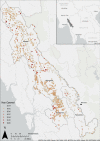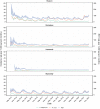Surveillance to achieve malaria elimination in eastern Myanmar: a 7-year observational study
- PMID: 35672747
- PMCID: PMC9171744
- DOI: 10.1186/s12936-022-04175-w
Surveillance to achieve malaria elimination in eastern Myanmar: a 7-year observational study
Abstract
Background: The collection and utilization of surveillance data is essential in monitoring progress towards achieving malaria elimination, in the timely response to increases in malaria case numbers and in the assessment of programme functioning. This paper describes the surveillance activities used by the malaria elimination task force (METF) programme which operates in eastern Myanmar, and provides an analysis of data collected from weekly surveillance, case investigations, and monitoring and evaluation of programme performance.
Methods: This retrospective analysis was conducted using data collected from a network of 1250 malaria posts operational between 2014 and 2021. To investigate changes in data completeness, malaria post performance, malaria case numbers, and the demographic details of malaria cases, summary statistics were used to compare data collected over space and time.
Results: In the first 3 years of the METF programme, improvements in data transmission routes resulted in a 18.9% reduction in late reporting, allowing for near real-time analysis of data collected at the malaria posts. In 2020, travel restrictions were in place across Karen State in response to COVID-19, and from February 2021 the military coup in Myanmar resulted in widescale population displacement. However, over that period there has been no decline in malaria post attendance, and the majority of consultations continue to occur within 48 h of fever onset. Case investigations found that 43.8% of cases travelled away from their resident village in the 3 weeks prior to diagnosis and 36.3% reported never using a bed net whilst sleeping in their resident village, which increased to 72.2% when sleeping away from their resident village. Malaria post assessments performed in 82.3% of the METF malaria posts found malaria posts generally performed to a high standard.
Conclusions: Surveillance data collected by the METF programme demonstrate that despite significant changes in the context in which the programme operates, malaria posts have remained accessible and continue to provide early diagnosis and treatment contributing to an 89.3% decrease in Plasmodium falciparum incidence between 2014 and 2021.
© 2022. The Author(s).
Conflict of interest statement
The authors declare that they have no competing interests.
Figures




References
-
- WHO . World Malaria Report 2021. Geneva: World Health Organization; 2021.
-
- Landier J, Parker DM, Thu AM, Lwin KM, Delmas G, Nosten FH, et al. Effect of generalised access to early diagnosis and treatment and targeted mass drug administration on P. falciparum malaria in Eastern Myanmar: an observational study of a regional elimination programme. Lancet. 2018;391:1916–1926. doi: 10.1016/S0140-6736(18)30792-X. - DOI - PMC - PubMed

